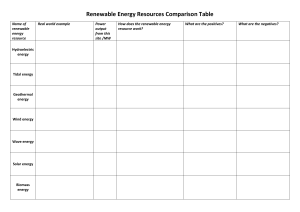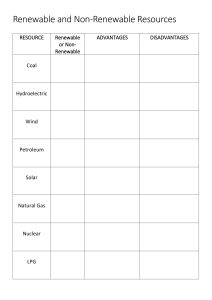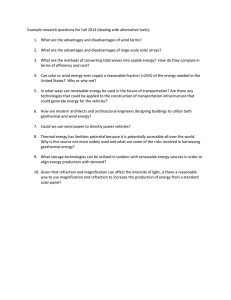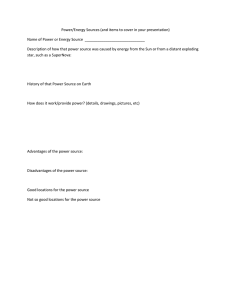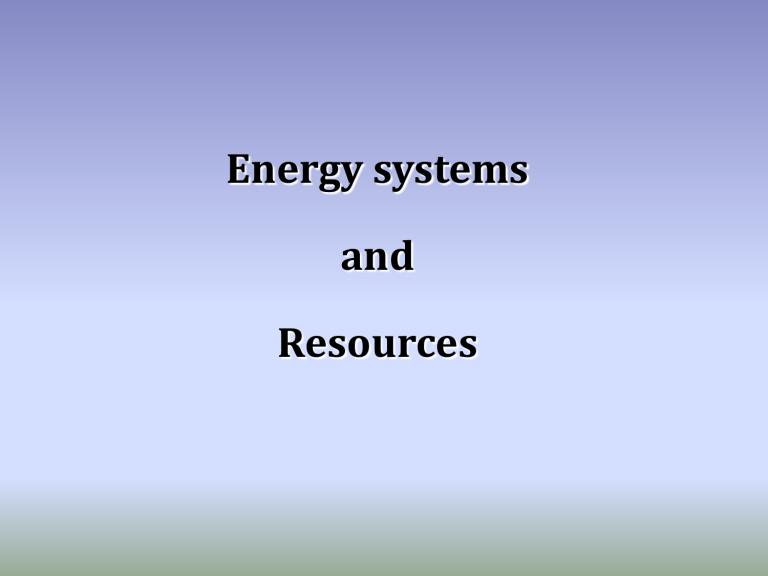
Energy systems and Resources Learning objectives • Define energy • Explain energy systems • Discuss classification of energy sources 1.0 Energy Systems and Resources 1.1 Introduction • Energy comes from an energy source also known as resource. • Each of these sources has a starting form and has to be converted into different forms for our convenient use by help of an energy system 1.0 Cont… • Energy system is a set of processes involving production, transformation, transport and distribution of energy sources e.g. geothermal energy system shown below. These systems are made up of a sequence of conversions with inputs and outputs that transform an energy resource into a form usable for human work or heating. 1.0 Cont… • Energy refers to the ability of a system to cause external action and is calculated by: Energy E Power P Time T SI units Joules J 1.0 Cont… 1.2 Classification of Energy Energy can be classified into two main categories: 1. Potential energy Potential energy is stored energy and the energy of position (gravitational). It exists in various form such as elastic potential, gravitational etc. 2. Kinetic energy Kinetic energy is energy in motion- the motion of waves, electrons, atoms, molecules and substances. It also exists in various forms such as sound, mechanical, thermal, electrical etc. 1.0 Cont… 1.3 Energy Resources • Energy resource is a natural resource that can be converted by humans into other forms of energy in order to do useful work. • There is a variety of resources that provide us energy for different purposes which includes: Wind energy Biomass Energy Fossil fuel Energy Geothermal Energy Nuclear energy Ocean Tidal and Wave energy Solar Energy Water Energy 1.0 Cont… 1.3.1 Classification of Energy Resources • Based on usability energy resources may be classified into primary and secondary resource: Energy Resources Primary resource Secondary resource (found or stored in nature ) Coal Biomass Natural gas (derived from the transformation of primary energy) wind Nuclear fuels Sun Bio fuels Steam Electricity and Heat 1.0 Cont… • Based on transaction, energy resources may be classified as commercial and non-commercial energy resource: Energy Resources Commercial Energy (available in the market for a definite price) Coal Electricity Petroleum products Non-Commercial Energy (not available in the commercial market for a price) firewood cattle dung Agricultural wastes 1.0 Cont… • Based on energy storage or cycling time involved, energy resources may be classified as renewable and non-renewable energy resouce: Energy Resources Renewable Energy (Biomass based and replenishable) solar energy Geothermal energy wing energy Water energy Biomass Non-Renewable Energy (Available in limited amount) Coal Petroleum fossil fuels 1.0 Cont… 1. Wind Energy Sources Wind energy is the oldest and cleanest forms of energy and the most developed of the renewable energy sources. Could be used without producing by-products that are harmful to nature ADVANTAGES DISADVANTAGES Renewable Only practical in windy areas Relatively inexpensive to generate Produces less energy Does not produce air pollution Wind mill is big, bulky and inconvenient to use as compared to other forms of energy 1.0 Cont… 2. Fossil Fuels - Conventional Source of Energy A fossil fuel is a fuel formed by natural processes, such as anaerobic decomposition of buried dead organisms, containing energy originating in ancient photosynthesis Coal, crude oil and natural gas are examples of fossil fuels ADVANTAGES DISADVANTAGES Easy to get & transport Nonrenewable Provide a large amount of thermal energy Costly Can be used to generate electrical energy and make products, such as Plastic, paints etc. Burning coal releases substances that can cause pollution 1.0 Cont… 3. Nuclear Energy Energy released from nuclear reactions is called nuclear energy 1.0 Cont… In a nuclear power plant, thermal energy released from splitting uranium atoms is transformed into electrical energy ADVANTAGES DISADVANTAGES Very concentrated form of energy Produces radioactive waste Power plants do not produce smog Radioactive elements are nonrenewable 1.0 Cont… 4. Solar Energy Solar energy is energy derived from the sun in form of solar radiation It can be harnessed by either direct sources (like solar cooker, solar steam systems, solar dryer, solar cells, etc.), or indirect sources (biomass production, wind, tidal, etc.) ADVANTAGES DISADVANTAGES Almost limitless source of energy Expensive to use for large scale energy production Does not produce air pollution Only practical in sunny areas Renewable It is intermittent in nature 1.0 Cont… 5. Biomass Energy Biomass energy is energy obtained from organic material made from plants and animals (micro-organisms) Biomass as a fuel consists of organic matter such as industrial waste, agricultural waste, wood, and bark ADVANTAGES DISADVANTAGES Cleaner burning than oil It is dispersed and land intensive source Abundant Produces smoke Renewable It has low energy density 1.0 Cont… 6. Geothermal Energy Geothermal energy is energy derived by tapping the heat of the earth in form of steam from geothermal hotspots like volcano, geysers, hot springs (etc.) 1.0 Cont… The heat from these geothermal hotspots is altered in the form of steam which is used to run a steam turbine that can generate electricity ADVANTAGES DISADVANTAGES Reliable High cost of investment Abundant supply Emission of greenhouse gases during extraction Sustainable Non-renewable 1.0 Cont… 7. Ocean Tidal and Wave energy Tidal power or tidal energy is a form of hydropower that converts the energy obtained from tides into useful forms of power, mainly electricity Tides are the rise and fall of sea level caused by the gravitational pull of the moon and the sun on the Earth Wave energy, also known as ocean energy is defined as energy harnessed from oceanic waves ADVANTAGES DISADVANTAGES Running cost is Low efficiency negligible Continuous power supply High installation cost 1.0 Cont… 8. Water energy/Hydro energy Water energy also known as hydro power, is the use of falling or fast-running water stored in dams to produce electricity or to power machines ADVANTAGES DISADVANTAGES Renewable Expensive to build Low emissions Limited reserves Reliable Draught potential Safe Environmental consequences Acknowledgements 1. Boyle, Godfrey. 2004. Renewable energy. Oxford University Press, 450 pages (ISBN: 0-19-926178-4). 2. Boyle, Godfrey, Bob Everett, and Jane Ramage 2004. Energy systems and sustainability: Power for a sustainable future. Oxford University Press, 619 pages (ISBN: 0-19-926179-2) 3. Sudheer, K.P, Sureshkumar, P.K, Sreekutty Suresh V, and Greeshma, K. 2018. Lecture Notes of Renewable Energy. Published by The Associate Dean, College of Horticulture, Vellanikkara, Kerala Agricultural University. THE END
